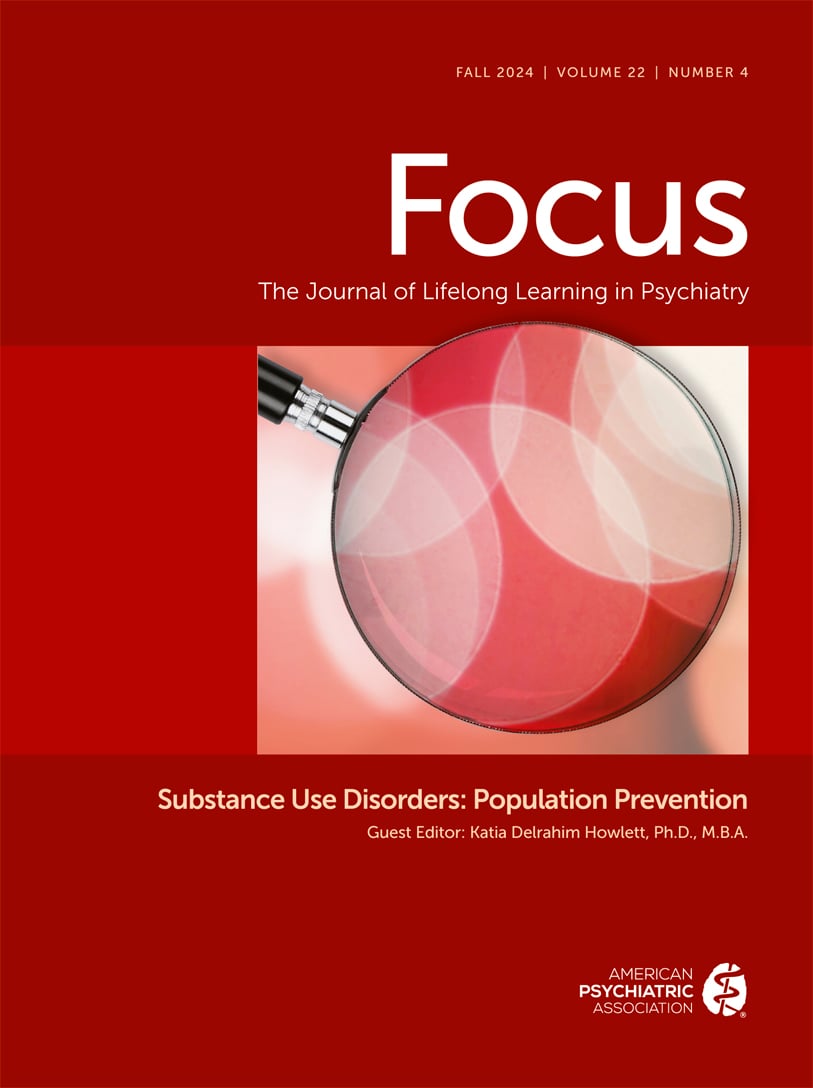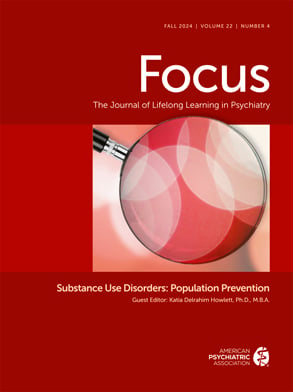Substance use disorders are an increasingly prevalent class of psychiatric diagnoses. Use disorders include, but are not limited to, alcohol, tobacco, cannabis, opioids, and stimulants. According to the 2022 National Survey on Drug Use and Health, 48.7 million Americans ages 12 and older were diagnosed as having a substance use disorder in the prior year (
1). Such disorders are more likely to affect young males in metropolitan counties, with alcohol being the substance with the largest percentage of first-time users (
2). Overdoses are a leading cause of death in America, particularly among persons under age 45, with more than 70,000 deaths occurring annually and increasing at an approximate 4% annual rate (
2). The largest proportion of these deaths are from opioids. From 2012 to 2015, there was a 264% increase in synthetic opioid overdose deaths (
2). The age-adjusted rate of overdose deaths from synthetic opioids have continued to increase from 2013 to 2022 (
3). Substance use also incurs a large financial burden on the country for health care needs, lost work productivity, and other costs. In 2017, this financial burden in America was $272 billion (
2), which is higher than the individual gross domestic product of countries such as Portugal, New Zealand, and Greece (
4).
Although treatment for substance use disorders is available, in 2022, only 26% of persons diagnosed as having a substance use disorder received any treatment for the condition (
5). Despite myths to the contrary, recovery can be achieved; 21.3 million Americans report that they are in recovery from a substance use disorder (
6). However, there is a substantial number of individuals who feel that they do not need treatment. In 2022, of the more than 40 million Americans who needed but did not receive treatment for a substance use disorder, only less than 2 million felt they required treatment (
6). These individuals who need but do not seek treatment may decompensate to the point of being unable to care for themselves and/or becoming a danger to themselves. It is for these reasons that some states have adopted involuntary commitment laws for substance use treatment. One such example arose from Washington State. Ricky’s Law: Involuntary Treatment Act was passed in 2018 and allows mental health professionals to involuntarily commit an individual to a secure facility for involuntary treatment due to a substance use disorder (
7,
8). Other states have followed suit; 37 states have some form of involuntary treatment for substance use (
9). Once a measure only utilized for individuals with severe mental illness, practitioners are now faced with the ethical dilemmas put in front of them: preserve a patient’s autonomy and allow them to refuse treatment despite the individual potentially being a grave risk to themselves or choosing the tenet of beneficence by providing treatment that the patient may lack the insight to recognize that they require.
Case 1
Mr. Jones is taken to the emergency department after his wife found him unresponsive. Knowing that Mr. Jones frequently uses opioids, Mrs. Jones immediately administered naloxone and called emergency services. Overnight in the emergency department, the medical team cleared Mr. Jones. As Mr. Jones has a 25-year history of opioid use, multiple overdoses, and unsuccessful outpatient treatments, you (the psychiatrist) consider the possibility of involuntary commitment for the treatment of his opioid use disorder.
1.1.
What legal doctrine would allow you to initiate involuntary commitment?
1.2.
Mr. Jones is the son of a benefactor of the hospital. Ms. White was a patient whom you evaluated last night with opioid use disorder as well; however, she lives in a shelter and is unemployed. Discharging Ms. White to her shelter with an outpatient appointment but considering a higher level of care for Mr. Jones, despite their similar psychiatric circumstances, violates which core ethical principle of health care?
1.3.
You decide to proceed with involuntary commitment for Mr. Jones in order to treat his substance use disorder. You complete the necessary affidavits and submit them to the court. By what standard of proof must a judge find sufficient evidence in order for a patient to be civilly committed?
B.
Preponderance of the evidence
C.
Clear and convincing evidence
D.
Beyond a reasonable doubt
1.4.
What landmark 1979 U.S. Supreme Court decision provides the holding for the answer to question 1.3?
D.
Lipari v Sears, Roebuck & Co.
Case 2
Mrs. Brown has experienced alcohol use disorder for more than 20 years. She lives in Kentucky and her son visits from out-of-state once a year. Mrs. Brown’s son attempted to find suitable treatment for his mother; however, Mrs. Brown would never attend follow-up appointments and was nonadherent to medication. Due to her lack of treatment, her condition has deteriorated year after year.
2.1.
Mrs. Brown’s son gathered the necessary petitions from psychiatrists that are needed for his mother’s involuntary civil commitment in order to treat her alcohol use disorder. What additional requirement under the Matthew Casey Wethington Act for Substance Abuse Intervention (Casey’s Law), the law governing civil commitment for substance use disorder treatment in Kentucky, must be satisfied prior to a judge honoring the petition?
C.
Pledge of financial commitment
E.
Additional petition from a primary care physician
2.2.
Which U.S. Supreme Court decision held that criminalizing public intoxication did not violate the 8th Amendment?
2.3.
What long-acting opioid antagonist might treat Mrs. Brown for her alcohol use disorder?
2.4.
Mrs. Brown’s chronic alcohol use has led to a diagnosis of chronic liver disease. If Mrs. Brown also experienced schizophrenia, what antipsychotic is excreted by the kidneys and therefore would be safe and not need any dose adjustments?
Answers
1.1.
The answer is D. The doctrine of parens patriae comes from the Latin for “parent of the nation” and also is commonly known as “police power.” This doctrine sees the government as the ultimate authority and protector for those who are unable to protect or care for themselves. In loco parentis is related to parens patriae; however, it is an incorrect answer in this situation. This legal doctrine is from the Latin for “in place of the parent” and is commonly used in cases that involve children or in which the best interest of a child is at stake. Habeas corpus, or “that you have the body,” is a legal action that can be filed to contest an unlawful detention or imprisonment. Stare decisis comes from the Latin for “to stand by things decided” and is often invoked by courts when relying on precedent or previous legal standards that have been upheld. Finally, nolo contendere, or “I do not wish to contend,” is a plea one can put forth in a criminal prosecution in which one accepts a conviction without admitting guilt.
1.2.
The answer is C. The tenet of justice centers itself on the idea of fairness and equal distribution of resources. In this example, as both Mr. Jones and Ms. White had similar psychiatric circumstances, using the principle of justice, they should both be afforded equal treatment. The principle of beneficence is to do what is right for the patient and have the patient’s welfare in mind during any situation. The principle of autonomy, or respect for persons, is to defer to the patient in decision making if they are competent to do so. In the aforementioned example, involuntary commitment attempts to balance autonomy with beneficence. Nonmaleficence is the so-called golden rule of medicine, to do no harm to a patient. Honesty, although a principle all should regard, is not one of the core ethical principles of health care.
1.3.
The answer is C. In civil proceedings, such as involuntarily committing a patient to substance use treatment, the constitutional minimum standard of proof is the “clear and convincing” standard. This standard is applied as it is greater than a “preponderance of the evidence” standard, because there is a loss of one’s liberty at stake. However, the “clear and convincing” standard is lower than a “beyond a reasonable doubt” standard as civil commitment is not punitive and there is periodic review leading to one’s release. “Probable cause” is the standard used to issue a search warrant or to issue a criminal indictment, which is even lower than the “preponderance of the evidence” standard.
1.4.
The answer is B. Addington v Texas’s (1979) holding set the standard for clear and convincing evidence as the constitutional minimum standard in cases involving civil commitment. Lessard v Schmidt (1972) is a related civil commitment case; however, one that involves due process safeguards of civil commitment such as notice of detention, right to counsel, and exclusion of hearsay evidence. Vitek v Jones (1980) is a U.S. Supreme Court case that held that the involuntary transfer of prisoners to a psychiatric hospital violates the 14th Amendment’s due process clause. Lipari v Sears, Roebuck & Co. (1980) is a landmark case stemming from Tarasoff v Regents of the University of California (1976) that extended the duty to warn to any foreseeable victims. Dusky v United States (1960) is the landmark U.S. Supreme Court decision that outlines the test for competency to stand trial.
2.1.
The answer is C. Of the 37 states that allow for some form of involuntary commitment for the treatment of a substance use disorder, three states (Kentucky, Ohio, and Utah) require a pledge of financial commitment to pay for treatment as a prerequisite to honoring the petition (
10). Specifically, Kentucky law states, “Any petition filed…shall be accompanied by a guarantee…obligating that person to pay all costs for treatment of the respondent for substance use disorder that is ordered by the court” (
11). This is not merely a de minimis cost, but one that can be a significant barrier to necessary treatment and creates further disparities in psychiatric care.
2.2.
The answer is A. In 1968, the U.S. Supreme Court ruled that a Texas statute that criminalizes public intoxication was not a violation of the Constitution’s 8th Amendment protections against cruel and unusual punishment. This case is in contrast to the 1962 U.S. Supreme Court decision of Robinson v California, which held that punishing a person for a medical condition (in this case, “narcotic addiction”) is a violation of the 8th Amendment. Powell v Alabama (1932) held that a state must inform illiterate defendants who are charged with a capital crime that they have the right to counsel and further, must appoint counsel for those who are indigent. Panetti v Quarterman (2007) held that the execution of a defendant who does not understand the reason for their punishment violates the 8th Amendment. Finally, Ake v Oklahoma (1985) held that a state must provide an indigent defendant with psychiatric assistance at no cost in preparing an insanity defense.
2.3.
The answer is E. Naltrexone is an opioid antagonist that blocks the reward and craving for alcohol and comes in both oral and long-acting injectable formulations. Similar sounding, naloxone is also an opioid antagonist; however, is primarily used to reverse the effects of opioids and is commonly administered via nasal spray. Acamprosate works at the N-methyl-D-aspartate receptor in order to reduce withdrawal symptoms of alcohol. Disulfiram inhibits aldehyde dehydrogenase in order to cause unpleasant symptoms when alcohol is ingested, a so-called aversive medication. Ondansetron is a 5-HT3 receptor antagonist that is used as an antiemetic.
2.4.
The answer is A. Paliperidone is primarily excreted by the kidneys and is considered safe in mild to moderate liver disease (
12). The other antipsychotics listed undergo some metabolism via the liver and dose adjustments should be made in patients with chronic liver disease (
13).

